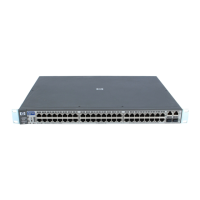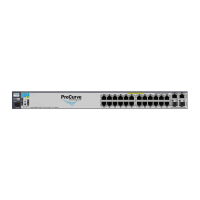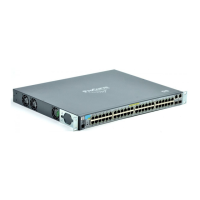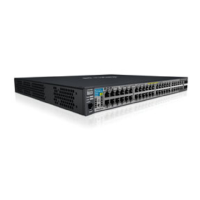13-26
802.1w Rapid Spanning Tree Protocol (RSTP) and 802.1d Spanning Tree Protocol (STP)
802.1p Spanning-Tree Protocol (STP)
Syntax: spanning-tree [ethernet] <port-list>
path-cost <1 - 65535>
priority <0 - 255>
mode <norm | fast>
Default: See table 13-4 on page 13-25.
For example, the following configures ports C5 and C6 to a path cost of
15, a
priority of
100, and fast mode:
HPswitch(config)# spanning-tree c5-c6 path-cost 15
priority 100 mode fast
STP Fast Mode
For standard STP operation, when a network connection is established on a
device that is running STP, the port used for the connection goes through a
sequence of states (Listening and Learning) before getting to its final state
(Forwarding or Blocking, as determined by the STP negotiation). This
sequence takes two times the forward delay value configured for the switch.
The default is 15 seconds on HP switches, per the IEEE 802.1D standard
recommendation, resulting in a total STP negotiation time of 30 seconds. Each
switch port goes through this start-up sequence whenever the network con-
nection is established on the port. This includes, for example, when the switch
or connected device is powered up, or the network cable is connected.
A problem can arise from this long STP start-up sequence because some end
nodes are configured to automatically try to access a network server when-
ever the end node detects a network connection. Typical server access
includes to Novell servers, DHCP servers, and X terminal servers. If the server
access is attempted during the time that the switch port is negotiating its STP
state, the server access will fail. To provide support for this end node behavior,
the Switches 2650 and 6108 offer a configuration mode, called “Fast Mode”,
that causes the switch port to skip the standard STP start-up sequence and
put the port directly into the “Forwarding” state, thus allowing the server
access request to be forwarded when the end node needs it.
If you encounter end nodes that repeatedly indicate server access failure when
attempting to bring up their network connection, and you have enabled STP
on the switch, try changing the configuration of the switch ports associated
with those end nodes to STP Fast Mode.
!Software.book Page 26 Thursday, October 10, 2002 6:10 PM

